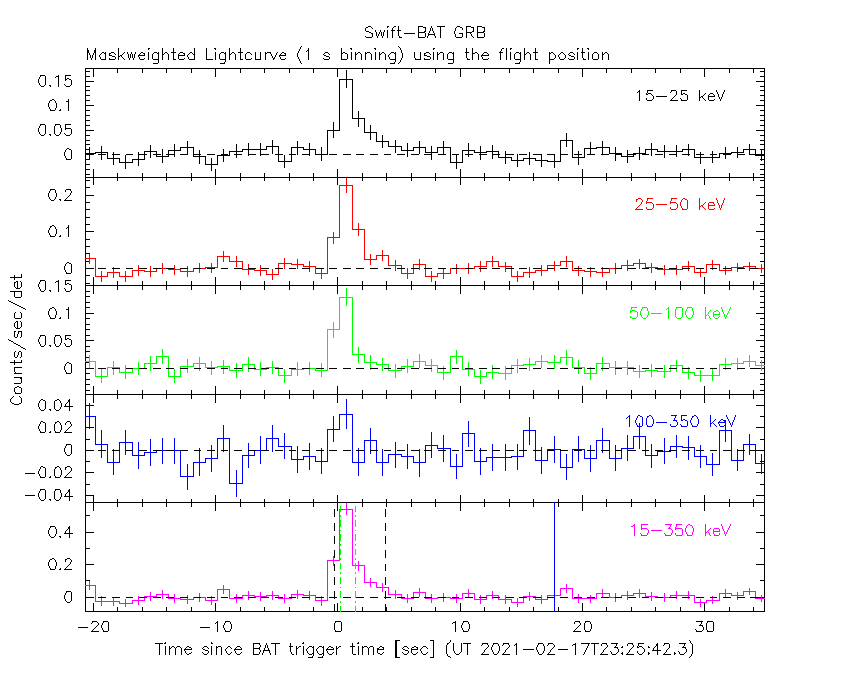
K.K. Simpson (PSU) and D.N. Burrows (PSU) for the Swift team
At 23:25:42 UT, the Swift Burst Alert Telescope (BAT) triggered and located GRB 210217A (trigger=1033264) (Simpson et al. GCN Circ. 29521). Swift slewed immediately to the burst. At the time of the trigger, the initial BAT position was 114° from the Sun (8.4 hours East) and 68° from the 33%-illuminated Moon. Table 1 contains the best reported positions from Swift, and the latest XRT position can be viewed at http://www.swift.ac.uk/xrt_positions.
Simpson et al. (GCN Circ. 29521) reported the discovery with UVOT of an optical afterglow. Table 2 is a summary of GCN Circulars about this GRB from observatories other than Swift.
Standard analysis products for this burst are available at https://gcn.gsfc.nasa.gov/swift_gnd_ana.html.
As reported by Sakamoto et al. (GCN Circ. 29534),
the BAT ground-calculated position is RA, Dec = 97.578, 68.715 deg which is RA(J2000) = 0
The mask-weighted light curve (Figure 1) shows a single-peaked FRED-like structure that starts and peaks at ~
The time-averaged spectrum from T-0.65 to T+4.89 s is best fit by a simple power-law model.
The power law index of the time-averaged spectrum is 2.01 ± 0.16.
The fluence in the 15-150 keV band is 6.8 ± 0.7 x 1
The results of the batgrbproduct analysis are available at https://gcn.gsfc.nasa.gov/notices_s/1033264/BA/.
Analysis of the initial XRT data was reported by Burrows et al. (GCN Circ. 29538). We have analysed 13 ks of XRT data for GRB 210217A, from 109 s to 210.9 ks after the BAT trigger. The data are entirely in Photon Counting (PC) mode. The enhanced XRT position for this burst was given by Evans et al. (GCN Circ. 29525).
The light curve (Figure 2) can be modelled with an initial power-law decay with an index of α=0.3 (+0.4, -0.5), followed by a break at T+1790 s to an α of 1.25 (+0.13, -0.12).
A spectrum formed from the PC mode data can be fitted with an absorbed power-law with a photon spectral index of 1.97 (+0.23, -0.22). The best-fitting absorption column is 2.5 (+0.9, -0.8) x 1
A summary of the PC-mode spectrum is thus:
Total column: 2.5 (+0.9, -0.8) x 1
Galactic foreground: 8.7 x 1
Excess significance: 3.3 σ
Photon index: 1.97 (+0.23, -0.22)
The results of the XRT team automatic analysis are available at http://www.swift.ac.uk/xrt_products/01033264.
The Swift/UVOT began settled observations of the field of GRB 210217A 103 s after the BAT trigger
(Simpson GCN Circ. 29555).
A source consistent with the XRT position *** POSITION REFERENCE is GCN_Notice *** is detected in the initial UVOT exposures.
Table 3 gives preliminary
magnitudes using the UVOT photometric system
(Breeveld et al. 2011, AIP Conf. Proc., 1358, 373).
No correction has been made for the expected extinction in the Milky Way
corresponding to a reddening of

Figure 1. The BAT
mask-weighted light curve in the four individual and total
energy bands. The units are counts

Figure 2. The XRT light curve.
Any data from a crosshatched region are not included in the fit.
| RA (J2000) | Dec (J2000) | Error | Note | Reference |
|---|---|---|---|---|
| 0 |
+68°43'30.6" | 0.46" | UVOT-refined | Simpson GCN Circ. 29555 |
| 0 |
+68°43'31.0" | 1.5" | XRT-final | UKSSDC |
| 0 |
+68°43'31.3" | 1.9" | XRT-enhanced | Evans et al. GCN Circ. 29525 |
| 0 |
+68°42'55.4" | 1.4' | BAT-refined | Sakamoto et al. GCN Circ. 29534 |
| Band | Authors | GCN Circ. | Subject | Observatory | Notes |
|---|---|---|---|---|---|
| Optical | Zhu et al. | 29523 | NEXT early optical afterglow observations |
Xinjiang Astro. Obs. | detection |
| Optical | Zheng and Filippenko | 29533 | KAIT Optical Observations | KAIT | marginal detection |
| Optical | Shrestha et al. | 29535 | Liverpool Telescope First Hour Observations |
Liverpool Telescope | light curve |
| Optical | Kumar et al. | 29539 | 1.3m DFOT optical detection | Nainital | detection |
| Optical | Pankov et al. | 29577 | Mondy optical observations | Mondy | light curve |
| Optical | Dimple et al. | 29591 | 3.6m DOT optical observations | DOT | detection |
| Gamma-ray | Fletcher | 29536 | Fermi GBM Sub-Threshold Detection | Fermi GBM |
| Filter | Exp(s) | Mag | ||
|---|---|---|---|---|
| white | 103 | 253 | 147 | 18.80 ± 0.06 |
| u | 315 | 508 | 190 | 18.64 ± 0.11 |
Table 3. UVOT observations reported by Simpson (GCN Circ. 29555). The start and stop times of the exposures are given in seconds since the BAT trigger. The preliminary detections and 3-σ upper limits are given. No correction has been made for extinction in the Milky Way.
March 2, 2021